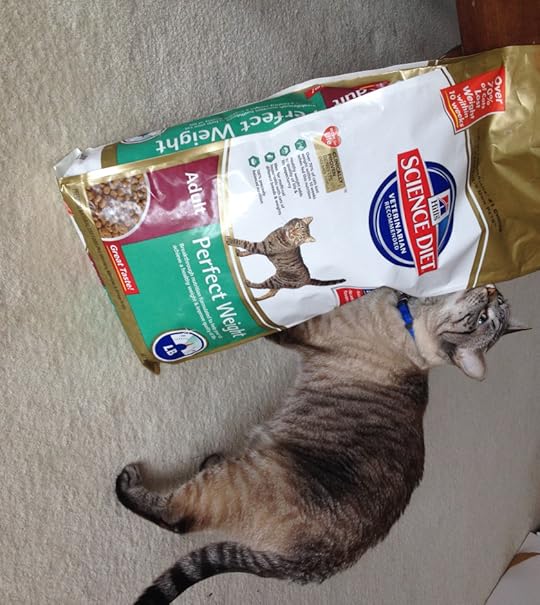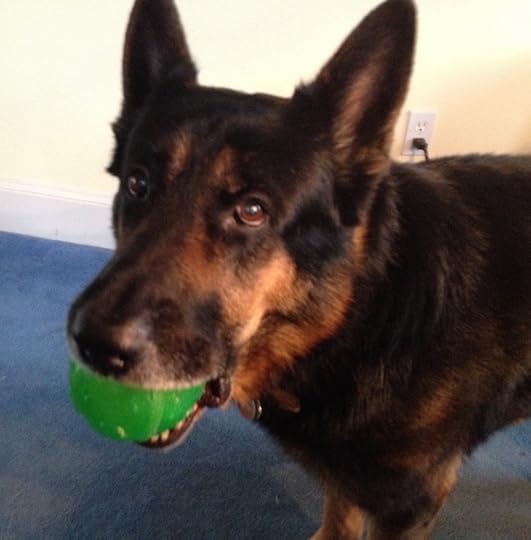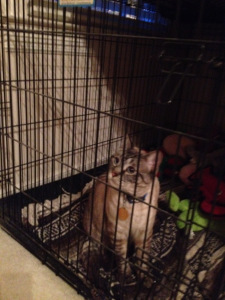Amy Shojai's Blog, page 93
March 24, 2015
Do You Speak Dog? Learn How in This Webinar
Do You Speak Dog? Learn How in This Webinar

Image courtesy DepositPhotos.com
Hey there Sweet Peeps! Thanks to the great folks at Pet Healthy Store, I’ll present a fun AND FREE! webinar this Thursday March 26 (3:30 EDT).
SAY, WHAT? How Learning
“Dog-Speak” Solves Your Pet Peeves
This is based on the information from my ComPETability(Dogs) book, and is so important I wanted to share these basics for free. You will learn :
Three ways dogs communicate.
How to “listen” to what your dog says.

Ways to “talk” so your dog WANTS to understand.
How dogs learn, & quick fixes for obnoxious behaviors.
Q&A to follow so bring your fun doggy questions to Ask Amy.
And yes…did you notice the neato-torpedo new COVER for the book? I am wagging my virtual tail!
Stay tuned–next week we’ll have the CAT WEBINAR and learn how to “speak cat.” Hey, the fur-kids demand equal time!
I love hearing from you, so please share comments and questions. Do you have an ASK AMY question you’d like answered–lick the banner, above. Be sure to visit my PetHealthyStore for paw-some products for your furry wonders! Stay up to date on all the latest just subscribe the blog, “like” me on Facebook, and get a FREE BOOK when you sign up for Pet Peeves newsletter. Stay up to date with the latest book give aways, kewl product offers, and appearances related to my THRILLERS WITH BITE!
AMY SHOJAI'S Bling, Bitches & Blood - Pet-centric Writer-icity & Thrillers With BITE!
March 23, 2015
Cat Nutrition & Animal Shelter Adoptions: #FoodShelterLove
Cat Nutrition & Animal Shelter Adoptions: #FoodShelterLove

Karma loves his Perfect Weight food. Image copr. Amy Shojai, CABC
This post is sponsored by Hill’s. I am being compensated for helping spread the word about Hill’s® Science Diet® and Food, Shelter & Love™ Program, but BLING, BITCHES & BLOOD BLOG only shares information I feel is relevant to my readers. Hill’s Pet Nutrition, Inc. is not responsible for the content of this article.

Image Courtesy of Hill’s Pet Nutrition
I wasn’t planning an animal shelter adoption when a kitten showed up on my patio just over a year ago. Karma-Kat acted starved for attention–and also food–and immediately purred his way into our hearts. Yet integrating a new cat into our household proved challenging on several levels, especially cat nutrition issues. In fact, if he’d been at the shelter, Karma’s food-obsession and subsequent weight gain could have kept him from being adopted, because Karma wanted to eat EVERYTHING.
Why Cats Steal Food
Cats that have had to fend for themselves as strays may be more prone to food obsession–yes, food actually can affect kitty mood. Karma was about 8 months old and weighed 8 pounds when he arrived. He probably hadn’t been out on his own very long, but long enough to figure out that you better EAT whenever/wherever you find it. So once the prelim intros were done between him and the 18-year-old Seren-Kitty and 8-year-old Magical-Dawg, we discovered just how much of a foodie he was.
Karma ate Magic’s food (thank goodness Magic was tolerant!), not just from his bowl–Karma snuck into the pantry and chewed holes in Magic’s dog food bag. Karma cruised countertops and absconded with hubby’s bag of doughnuts. Karma pushed Seren aside and ate her therapeutic kidney diet food. And Karma swiped a kabob from my husband’s plate.

“I love cat food, too!” Dogs often relish cat food–Karma isn’t sharing! Image Copr. Amy Shojai, CABC
I know, I know! Magic and Seren’s food isn’t appropriate for a growing kitten (GROWING was the operative word, LOL!). Generally I recommend growing kittens be fed all they want of an appropriate kitten-specific ration but Karma really seemed to pack on the pudge doing this. While it only hurt Magic’s feelings to have his food stolen, 6-pound Seren needs every bit of her own food, and the added stress of guarding food bowls also impacts cats health.
The answer in Karma’s case was two-fold. 1) Manage the meals. 2) Feed Hill’s Science Diet Perfect Weight.
Hill’s Food, Shelter & Love Program Saves Cat Lives
The sad truth is that cats languish in shelters at this time of year, especially if they’re not a cute kitten. Hanging out in a cage all day gives little opportunity to stay a healthy, svelt weight and obese cats are less likely to get adopted.
That’s the impetus behind the Hill’s Food, Shelter & Love Program, which offers shelters the opportunity to offer quality nutrition to their resident cats and kittens. The Perfect Weight Diet helps slim down tubby tabbies to make them MORE adoptable by creating a weight loss system that new owners can then easily continue in the new home.

Karma’s tummy pudge has reduced since transitioning to Hill’s Perfect Weight food. Image Copr. Amy Shojai, CABC
I’d be a fan of this program anyway–Hill’s has provided over $240 million worth of food to nearly 1,000 shelters…and counting. But my personal experience with Karma tells me cats love the food, the program is easy to use and it works. In fact, over 70% of cats in this program lost weight within 10 weeks when fed this diet.
Find a shelter near you that participates in this plan. Scroll down to see the video about Stoli the kitty who has benefit from this program.
So do you have a pudgy kitty? Or do you have several pets that all need to eat different kinds of food? Maybe the tips that helped me will help you, too.
6 Tips to Manage Meals in MultiPet Homes
Your pets’ personalities, social interactions, and health issues impact appetite, diet and feeding schedule and how to manage your multi-pet household. If you’re lucky, all the cats can eat the same food but in many cases you’ll have pets of different ages or health status (or species!) that require very specific nutrition unique to their situation.

Image Courtesy of Hill’s Pet Nutrition
Last summer, I received a free sample of the Hill’s Science Diet Perfect Weight food as a Klout Perk. Karma had just turned a year old, and I’d grown more concerned about his burgeoning tummy. The sample came with measuring cups and feeding recommendations and–Karma LOVED the food! Well, so did Magic and Seren, so then I had that to contend with.
Choosing the right food is just the first step.When you share your home and heart with multiple pets, managing mealtime takes planning but it can be done. I’ve written about this in my ComPETability book series, and put it to work with Karma. Use one or more of the steps, below, to keep your pets munching from the right bowl.
No rule says all the pets must all be fed at once. Staggered feedings even 10 minutes apart may allow you to supervise each meal, and “ride herd” on the kitties who shouldn’t nibble from a particular formula.
Move bowls a safe distance apart. Eating near each other can create a positive association (other cat presence=yummy food). But if a cat stops chewing to stare at another feline, move the bowls further apart.
Cats that guard feeding stations or act fearful to eat in another pets’ present require separate times/areas/rooms to eat. Countertops, tables, various levels on the cat tree, or book shelves all offer valuable kitty real estate for individual feeding locations each cat can “own.” In our case, Seren-Kitty eats her meals on the dining room table next to her bed, while Karma-Kat’s feeding station is in the master bathroom clear across the house.
A pet or baby gate can segregate feeding stations by allowing only the more nimble cats to pass through or jump over. Our kitchen pet-gates control access to where Magic is fed. Neither Magic or Karma can get through these gates, but Seren is so tiny she gets to come and go. Hey, she’s the QUEEN and so has access to everything–but never has had interest in dog food.

Cats like Karma love to scrounge, “hunt” or swipe food, so give these cat burglars a legal outlet. Treat balls dispense a single meal to one cat, or treats to a group so as the cat plays, the dry food inserted into the ball or toy dispenses a kibble at a time. That keeps Kitty fed and entertained, and out of another feline’s bowl.
When cats of different sizes must eat two specific diets, such as a weight-reducing food for the big guy and a regular food for the little one, separate cats during meals in different rooms or create a ‘boxed lunch.’ Cut a tiny cat-size opening in a cardboard or transparent plastic storage box to fit the smaller cat, and place the small cat’s food bowl inside the box, where he can access and nibble at his leisure.
At his kitty wellness check two weeks ago, Karma weighed 13.2 pounds. He’s still a bit on the large size but his food obsession has waned. Now that he gets plenty of tasty food and doesn’t worry about going hungry, he’s relaxed around food (his own and others).
I love hearing from you, so please share comments and questions. Stay up to date on all the latest just subscribe the blog, “like” me on Facebook, and get a FREE BOOK when you sign up for Pet Peeves newsletter. Stay up to date with the latest book give aways, and appearances related to my THRILLERS WITH BITE!
AMY SHOJAI'S Bling, Bitches & Blood - Pet-centric Writer-icity & Thrillers With BITE!
March 18, 2015
Benefits Of Blogging? Authors Dish About Blogging
Benefits Of Blogging? Authors Dish About Blogging
 How kewl is this? I was interviewed for Susan Gilbert’s website where top authors give advice about blogging, and now have become part of this neato-torpedo infographic! There’s more about the interview at her site so please do check it out.
How kewl is this? I was interviewed for Susan Gilbert’s website where top authors give advice about blogging, and now have become part of this neato-torpedo infographic! There’s more about the interview at her site so please do check it out.
And for those who have landed here as a result of reading the interview, WELCOME! And I’d love to point you to some sample chapters of my September Day thriller series that (yes, indeed!) includes a dog viewpoint character and a trained cat. *s*
Read samples from the first book LOST AND FOUND here.
Read samples from the sequel HIDE AND SEEK here.
Hope you’ll return time and again for SQUEEE-licious pet care info, writer-icity fun and more.

I love hearing from you, so please share comments and questions. Do you have an ASK AMY question you’d like answered–lick the banner, above. Be sure to visit my PetHealthyStore for paw-some products for your furry wonders! Stay up to date on all the latest just subscribe the blog, “like” me on Facebook, and get a FREE BOOK when you sign up for Pet Peeves newsletter. Stay up to date with the latest book give aways, kewl product offers, and appearances related to my THRILLERS WITH BITE!
AMY SHOJAI'S Bling, Bitches & Blood - Pet-centric Writer-icity & Thrillers With BITE!
March 17, 2015
St. Patricks Day, Cats & Dogs: Playing Green
St. Patricks Day, Cats & Dogs: Playing Green

Image courtesy of DepositPhotos.com
Do you celebrate St. Patrick’s Day? Even though my pets are not of the Irish purr-suasion, they’ve got into the holiday fun.

Magic is ROCKIN’ his green tie. Image copr Amy Shojai, CABC

Seren’s not interested in green, unless it involves treats. Image Copr. Amy Shojai, CABC

Even Karma’s tag is green! Image copr. Amy Shojai, CABC

“Green, schmean, just THROW THE BALL!” Image copr. Amy Shojai, CABC
How do your pets celebrate the day? Green toys? I think later today the kitties will vote for some extra-green ‘nip!
I love hearing from you, so please share comments and questions. Do you have an ASK AMY question you’d like answered–lick the banner, above. Be sure to visit my PetHealthyStore for paw-some products for your furry wonders! Stay up to date on all the latest just subscribe the blog, “like” me on Facebook, and get a FREE BOOK when you sign up for Pet Peeves newsletter. Stay up to date with the latest book give aways, kewl product offers, and appearances related to my THRILLERS WITH BITE!
AMY SHOJAI'S Bling, Bitches & Blood - Pet-centric Writer-icity & Thrillers With BITE!
March 15, 2015
10 Kitten Adoption Do’s & Don’ts
10 Kitten Adoption Do’s & Don’ts

Image courtesy of DepositPhotos.com
It’s kitten season! Is a new fur-kid in your future? You’d think kitten care would be easy–just love ‘em and feed ‘em and listen to ‘em purr, right? But more goes into proper care than plopping food in a bowl and setting up a litter box.
Kittens adopted too early often bite and claw more than those who have been kitty-corrected by Mom and siblings. They also may be fearful or less tolerant of other cats, because they don’t understand all the proper feline etiquette of the social structure.
WHAT IS KITTEN SOCIALIZATION?
Dog people know about socialization of puppies, but kittens also benefit from socialization–except it comes WAY EARLIER in cat babies. The prime kitten socialization period falls between 2-7 weeks (yikes!) which means rescuers, shelter personnel and breeders are vital to the future well being of cats and how they look at their world. Socialization teaches kittens that people (and other cats, dogs, VETERINARIANS, carriers, cars, etc) are safe, positive normal parts of their lives, and also teaches what should be feared.
Proper socialization not only includes interaction with other cats, but positive handling by people during this critical period. That ensures the baby is well adjusted, confident, and emotionally healthy. I’ve got all the kitten must-knows in my COMPLETE KITTEN CARE, but you don’t need the book to get started. Before you adopt, review these 10 do’s and don’ts to ensure your kitten love lasts a lifetime.

Image courtesy of DepositPhotos.com
10 DO’s & DON’Ts OF KITTEN ADOPTION
1. Don’t adopt too early. Kittens adopted too young bite and claw more than those corrected by Mom and siblings. They also may be fearful or less tolerant of other cats because they don’t understand proper feline etiquette. Cat babies should stay with siblings and Mom for at least 12 to 16 weeks. That’s not always possible, though, and if you find yourself in that situation, it means you must be “cat-mom” and teach Junior claw, potty and other manners. It can help enormously to adopt two kittens at once, so they teach each other bite limits and target each other in play instead of your ankles.
2. Do see a vet ASAP. Kittens seem indestructible but get sick easily. A vet’s early diagnosis improves the chances of a speedy recovery. Screening tests and preventive care — vaccinations, flea prevention, worm medications — save lives and ensure your kitten grows to healthy adulthood.
3. Don’t bathe a kitten until it is at least 4 weeks old (12 to 16 weeks is better). Very young kittens can’t regulate body temperature and can become chilled from a bath. When you do bathe the kitten, use only kitten-safe products — adult cat or dog products can be toxic. Introduce combs and brushes immediately to longhair kittens to prevent grooming problems later on.
4. Do get kittens fixed. Spaying and neutering prevents pregnancy, urine spraying and health issues such as breast cancer. Female kittens can get pregnant as early as 4 months old, so don’t delay. Many shelters and professional breeders spay or neuter kittens at 8 to 12 weeks old (or once they weigh 2 lbs.) because babies recover more quickly than older cats.
5. Don’t rush introductions. Tiny kittens get lost or find trouble if not confined to a kitten-safe room. Let the new baby get used to one room so he knows the location of his litter box, bed, scratch objects, food bowl and toys. When you can’t watch him, confine him in his safe room. Even healthy-looking kittens could be contagious and the vet may recommend quarantine for up to 30 days. Resident pets accept new ones more quickly when only part of the house has been “invaded.” They can meet with sniffs and paw pats under the door until it’s safe for a nose-to-nose greeting.
6. Do kitten-proof the house. Kittens explore with paw pats, licking and biting. Chomping or clawing electrical cords or poisonous plants, swallowing string toys or hiding inside the clothes dryer can be deadly. Invest in knee pads and crawl around on your hands and knees for a kitten’s-eye view of potential dangers.
7. Don’t feed kittens milk, as it can cause diarrhea. Queen-replacement milk is available, but most babies eat solid food by 4 weeks old. Tiny tummies can’t eat enough to sustain in one meal, so feed three or four small meals daily until the kitten is 6 months old and twice daily thereafter. Monitor your kitten for a healthy appetite.
8. Do train your kitten. Routinely handle her ears, paws and mouth so she learns it’s not scary from you or the veterinarian. Make carriers fun playpens by tossing toys inside or turn them into napping spots so she’ll accept being in the carrier for visits to the vet or grandma’s.
9. Don’t declaw. Instead, train from the beginning with lots of legal scratch objects. Catch her in the act of scratching the right objects and reward with praise, treats or toys. Start trimming claws when you first get your kitten — one nail a day with your own clippers is fine — so she knows this is normal. That way if she forgets claw-training, she won’t damage property or skin with blunt claws.
10. Don’t let kittens outside until they’ve received all preventive vaccinations, microchip identification and parasite treatments — and you have a safe outdoor sanctuary. It’s nearly impossible to kitten-proof the great outdoors. Instead, leash-train your kitten to keep her safe and/or make the indoors so interesting with toys, cat trees and your love that the kitten never misses going out.
(Bonus) 11. Do let the kitten pick YOU! My Facebook friend Eliyahu offered this great comment and gave me permission to add to the list: “Don’t pick out the kitten. Let it pick you. It’s easy to be attracted to the one you think is the cutest or the prettiest, but that may not be the right one for you. I’ve always gone to the shelter with a couple hours free time when getting a kitten or cat. Our shelter back in Washington had a big cat room with all the cats together. I’d sit in a chair and let the kittens come to me, then see how each interacted with me and which one wanted the most to be with me. Here, there isn’t a cat room, so I had the worker bring kittens one at a time and played with them. The prettiest one turned out to be skittish around people, another just sat in the corner and stared. Finally, about eight kittens later, she brought one in that walked up, sniffed at me, climbed up on my lap and made it clear to us that she’d chosen me to be her human. A year later, Cenerentola still spends much of her time climbing on my lap and shoulders or sleeping by my feet when she’s not playing with the other cat.
What else have I missed? Are there other DO’s and DON’Ts that are important to include when planning your new kitten’s gotcha day? Please share!

All the kitten must-knows!
I love hearing from you, so please share comments and questions. Do you have an ASK AMY question you’d like answered–lick the banner, above. Be sure to visit my PetHealthyStore for paw-some products for your furry wonders! Stay up to date on all the latest just subscribe the blog, “like” me on Facebook, and get a FREE BOOK when you sign up for Pet Peeves newsletter. Stay up to date with the latest book give aways, kewl product offers, and appearances related to my THRILLERS WITH BITE!
AMY SHOJAI'S Bling, Bitches & Blood - Pet-centric Writer-icity & Thrillers With BITE!
March 12, 2015
Won Ton & Chopstick–A Cat and Dog Tale Told in Haiku
Won Ton & Chopstick–A Cat and Dog Tale Told in Haiku
 I rarely write book reviews on my blog, and even more rarely mention children’s books (so no…please don’t ask
I rarely write book reviews on my blog, and even more rarely mention children’s books (so no…please don’t ask  ). But today I must make an exception for a colleague and friend, because the books are just THAT GOOD!
). But today I must make an exception for a colleague and friend, because the books are just THAT GOOD!
A couple of years ago, I was sent a review copy of WON TON: A Cat Tale Told in Haiku when the book first launched in 2011. I don’t have kids (other than furry ones with four paws), but was so impressed I wrote a glowing 5-star review for cats.about.com–at the time I was the contributing writer for cat behavior topics. This book is a moving, powerful story of one cat’s adoption, told through the “voice” of a shelter cat. The gorgeous illustrations by Eugene Yelchin perfectly capture the cat’s perspective of shelter life, car ride to new home, and experiences adjusting to his adoptive family:
Nice place they got here.
Bed. Bowl. Blankie.
Just like home!
Or so I’ve been told.
Lee Wardlaw writes the text in senryu, a form of Japanese poetry similar to Haiku, which gives the cat’s tale a playful, poignant or humorous tone. The cat pretends not to care about being adopted, yet of course yearns for a forever home. Please, Boy, pick me. And once chosen and named Won Ton, the cautious cat must learn to trust enough to share his real name, and heart.
 Now the SEQUEL will be published on sale March 17, 2015. I have been waiting for this–it’s a subject very close to my heart, and addresses introducing new pets to resident ones–in this case a new puppy to the cat. Y’all know that my own book ComPETability: Solving Behavior Problems in Your Cat-Dog Household offers some prescriptive advice to prevent or solve issues.
Now the SEQUEL will be published on sale March 17, 2015. I have been waiting for this–it’s a subject very close to my heart, and addresses introducing new pets to resident ones–in this case a new puppy to the cat. Y’all know that my own book ComPETability: Solving Behavior Problems in Your Cat-Dog Household offers some prescriptive advice to prevent or solve issues.
But this new delightful book is perfect for parents and kids. WON TON and CHOPSTICK, A Cat and Dog Tale Told in Haiku offers the cat’s perspective when faced with a (hiss!) interloper.
Lee asked her publisher to send me an advanced reader’s edition and I will treasure this–it is everything I hoped and more. I LOVE LOVE LOVE this book! Won Ton has a happy life with his boy, until. . .
Ears perk. Fur prickles.
Belly low, I creep . . . peek . . . FREEZE!
My eyes full of Doom.
Both of these lovely books belong in every cat lover’s library, especially when you have children. The first book WON TON humorously educates children to basic cat behaviors and emotions, teaches empathy, and celebrates the gift of saving a life, while offering a snapshot of a shelter cat’s journey from a cage to finally embracing his new life and family with trust and love.
The second book WON TON and CHOPSTICK continues the “tail” with glee, humor and gentle insight of how resident pets feel about new pets puthimoutputhimoutputhimout but how with care all can be respected and learn to accept each other….
I shall call you…Friend.
I would love to send these books home with every new pet adoption. I cannot recommend these books highly enough.
Leave Blank:Do Not Change:
Your email:
I love hearing from you, so please share comments and questions. Do you have an ASK AMY question you’d like answered–lick the banner, above. Be sure to visit my PetHealthyStore for paw-some products for your furry wonders! Stay up to date on all the latest just subscribe the blog, “like” me on Facebook, and get a FREE BOOK when you sign up for Pet Peeves newsletter. Stay up to date with the latest book give aways, kewl product offers, and appearances related to my THRILLERS WITH BITE!
AMY SHOJAI'S Bling, Bitches & Blood - Pet-centric Writer-icity & Thrillers With BITE!
March 9, 2015
How to Crate Train Puppies & Kittens to Create #CrateHappyPets
How to Crate Train Puppies & Kittens to Create #CrateHappyPets

Find your crate expectations on sale in March at PetSmart! Image Copr. Amy Shojai, CABC

Hard crate, wire crate, soft carrier…see the selection on sale in March at PetSmart! Image Copr. Amy Shojai, CABC
 This post is sponsored by P
etSmart, and the BlogPaws Professional Pet Blogger Network. I am being compensated for helping spread the word about Containment Products and Education for your pet, but BLING, BITCHES & BLOOD BLOG only shares information I feel is relevant to my readers. PetSmart® is not responsible for the content of this article.
This post is sponsored by P
etSmart, and the BlogPaws Professional Pet Blogger Network. I am being compensated for helping spread the word about Containment Products and Education for your pet, but BLING, BITCHES & BLOOD BLOG only shares information I feel is relevant to my readers. PetSmart® is not responsible for the content of this article.

Magic at 8 weeks old and 11 pounds. Can you see the “divider” in this crate making it puppy-size? Image copr. Amy Shojai, CABC
SQUEEE! It’s puppy & kitten season, and just in time for YOUR big adoption gotcha-day celebration, during March local PetSmart® stores will have crate, kennels, carriers, and accessories on sale. There are many kinds of crates and carriers, from soft sided to hard plastic to wire, and in a variety of shapes and sizes.
IS CRATE TRAINING CRUEL?
Why would you want to “cage” that new baby? The way Junior-Dawg howls and Kitty-Kins yowls you’d think they’re being hung up by their furry toes!
Actually, it’s not cruel, but without proper introduction, it can be a wee bit scary. In my Complete Kitten Care and Complete Puppy Care books, I call this LIBERATION TRAINING. Teaching your new pet to accept the kitty carrier or puppy crate is a pet safety issue, but also means they get a ticket to ride…and travel beyond the confines of your house and yard.
That doesn’t mean your new puppy or kitten automatically understands the concept, though, so this blog post not only explains the benefits of crate training to YOU, it also helps you purr-suade your kitten and convince your canine that the notion is a CRATE IDEA. (sorry, couldn’t resist…)
BENEFITS OF CARRIERS & CRATES
Most puppies and kittens–and even their adult counterparts–feel more secure in a small, enclosed den-like area. That’s not to say your new baby should be in the crate for outrageous lengths of time. A youngster should be gradually introduced to the crate or carrier and never left unattended longer than he’s able to “hold it” for potty training.
Prime Nap Spot. A crate works well as a bed. And when a pet claims the spot for naps, it’s no longer scary, but becomes a happy, familiar place he feels secure.
Private Retreat. Because it’s enclosed, the puppy crate or kitty carrier also serves as a safe retreat to get away from other pets or pestering children. Don’t you want a private place of your own where you won’t be bothered? Pets are no different.
Safe Confinement. A crate also can be the safest place to confine that rambunctious baby to keep him from pottying in the wrong spot or cat-climbing to dangerous heights when you can’t watch him.
Ideal Travel Buddy. All pets need to travel by car to the veterinarian from time to time. That’s a STRANGER DANGER moment especially for cats, so already feeling safe and comfy in a familiar carrier puts your kitten or puppy at ease at the vet.
Potty Training Tool. For pups, it’s one of the best tools available for potty training. They don’t want to mess where they sleep, so just turning it into a bed prompts Junior-Dawg to let you know when he needs a potty break. Here are more tips on puppy potty training.
The perfect crate or carrier should be just large enough for a pet to go inside, turn around, and lie down to sleep. It can be a solid hard plastic container, wire mesh cage or soft-sided duffle-type carrier (for cats). While soft-sided pet carriers work great for transport, they may be too small and prove too tempting for chew-aholic pups to work well for safe confinement.

Today, Magical-Dawg has grown into his jumbo-size wire crate. The door is always open…except when it’s not! Image copr. Amy Shojai, CABC
Of course, puppies and kittens grow, so especially for larger dog breeds, take into account your pup’s future adult size before investing in a pricy dog crate. Large crates are available with partitions for you to “shrink” to puppy size, and then enlarge the area as your puppy matures. You can also purchase an adult-size crate, and insert a barrier like a plastic storage box that shrinks the space to puppy proportions until your pet grows to full size. That’s what I did with Magical-Dawg. He arrived at our house weighing about 11 pounds, and 8 years later he’s nearly 90 pounds. Today he doesn’t mind the crate at all, because it doubles as an enormous doggy toy box!
5 Tips to Crate Train Pets
The key to training pets to accept the carrier or crate is creating familiarity. You do that by introducing him to this new situation in a series of non-threatening, gradual steps.
Make It Familiar. While well-adjusted puppies and kittens tend to be curious, some tend toward shyness. Anything new prompts suspicion. So make the crate or carrier “part of the furniture” and set it out in the family room for your new pet to explore. Leave the door open or take it off, and let him sniff it inside and out. Don’t make a big deal out of it.

Karma Kat decided on his own that sleeping among soft toys that smell like his best buddy Magic is a VERY-GOOD-THING! He also likes playing with lure-toys while inside. Image copr. Amy Shojai, CABC
Make It A Happy Place. Place a snuggly kitty blanket or dog bed inside. Or you can toss a toy inside, to create positive experiences with the crate. For kittens, Ping Pong balls are great fun inside the hard crates. Karma actually LOVES hanging out inside Magic’s crate because of all the fuzzy toys. Both Karma-Kat and Seren-Kitty have smaller duffle-style carriers (set on top of Magic’s crate), and take turns sleeping in them–they’re out all the time, with doors open.

Karma looks surprised but not too bothered by the door being shut. When he travels to the vet, we use a soft sided carrier. Image copr. Amy Shojai, CABC
Offer A Treat. For puppies, find a puzzle toy that can be stuffed with a smelly, tasty treat. This should be a treat your puppy loves, but he ONLY gets the treat when inside the crate. Show it to him, let him smell and taste the treat, and then toss it inside the crate and shut the door—with the puppy outside the crate and the treat on the inside. And after he’s begged to get inside, open the door and allow him to chew and enjoy it for five minutes but only with the door shut. Catnip can work well with cats, but youngsters won’t react until they’re 6 months old, so getting kitty tipsy only works for more mature cats.
Teach Him Tolerance. If your puppy fusses let him out—but lock the treat back inside. You’re teaching him that wonderful things can be found inside the crate. Most pups learn to tolerate the door shut at least as long as they have something to munch. Praise the dickens out of him! He should know that staying calmly inside the crate earns him good things. Do the same with your kitten, using healthy treats or fun toys like chase-the-flashlight beam, but only inside the crate. Repeat several times over the next few days, each time letting the kitten out after five minutes.
Extend Crate Time. By the end of the week, you can begin increasing the time the pet spends in the crate. For small pups and kittens, pick up the carrier while he’s in it and carry him around, and then let him out. Take him in the carrier out to the car, sit there and talk to him, then bring him back into the house and release him—don’t forget to offer the treat. Soon, you should be able to take him for car rides in his carrier, without him throwing a fit. He’ll learn that most times, the carrier means good things for him—and the vet visit isn’t the only association it has.
For older cats, it can take several weeks to teach crate acceptance. Check out this PAW-some video from Catalyst Council on how to help your cats accept carriers. You–and your cats–will be glad you did.
So now it’s your turn. How are you teaching Junior Dog and Killer-Diller-Kitten to accept their carriers or crates? What about older pets–are they already crate trained? What worked best for your furry wonders? Please share tips to help out other pet lovers in the comments section!
Leave Blank:Do Not Change:
Your email:
I love hearing from you, so please share comments and questions. Stay up to date on all the latest just subscribe the blog, “like” me on Facebook, and sign up for Pet Peeves newsletter. Stay up to date with the latest book give aways and appearances related to my THRILLERS WITH BITE!
AMY SHOJAI'S Bling, Bitches & Blood - Pet-centric Writer-icity & Thrillers With BITE!
March 4, 2015
BlogPaws Contest Nose-to-Nose Nominee for Best Written Blog!
BlogPaws Contest Nose-to-Nose Nominee for Best Written Blog!
WOW! That’s all I can say at the moment. My blog FAKING IT: about scammers hurting legit service and emotional support animal services, has been nominated for a BlogPaws NOSE-TO-NOSE AWARD.
The other nominees are fantastic and include:
Mel Freer: Loose Dog
Ann Staub: How Important is Credibility
Janea Kelley: Diabetic Cat
You can see a list of all the nominees here.
I love hearing from you, so please share comments and questions. Do you have an ASK AMY question you’d like answered–post in the comments. Be sure to visit my PetHealthyStore for paw-some products for your furry wonders! Stay up to date on all the latest just subscribe the blog, “like” me on Facebook, and sign up for Pet Peeves newsletter. Stay up to date with the latest book give aways, kewl product offers, and appearances related to my THRILLERS WITH BITE!
AMY SHOJAI'S Bling, Bitches & Blood - Pet-centric Writer-icity & Thrillers With BITE!
March 2, 2015
Pros & Cons of Dog Neutering

Image courtesy of DepositPhotos.com
Yes, actually, there really are both pros and cons of puppy and dog neutering that may surprise you. It did me. After all, we’ve heard from animal welfare advocates for years preaching the gospel of spay/neuter. Heck, I preached this myself and for the majority of dogs and cats (ESPECIALLY cats!), “the big fix” is the best thing that ever happens to them.
There’s new evidence, though, that for dogs at least the pros and cons are not so black and white. While the University of Georgia’s sample of 40,139 canine death records from the Veterinary Medical Database from 1984-2004 concluded that neutered dogs could be expected to live a year and a half longer (on average) than intact dogs, other studies point out potential increases in hip dysplasia or cancer. Oy.
So what’s a responsible pet parent to do? One possible solution is a new non-surgical sterilization technique called Zeuterin from Ark Sciences, that renders the boy dogs incapable of fathering puppies but let’s them keep about 50 percent of their testosterone that makes a beneficial health difference especially in certain breeds.
Zeuterin™, an FDA-approved nonsurgical sterilization technique for male dogs from Ark Sciences, is now available in the US for all puppies three to ten months old. Termed “Zeutering,” the injectable treatment offers an alternative to the traditional surgical castration methods.
Most pet lovers recognize that neutering boy puppies they don’t plan to breed or show can be the responsible choice. Sterilization reduces a number of potential behavior problems such as roaming, marking, mounting and fighting. The University of Georgia looked at a sample of 40,139 canine death records from the Veterinary Medical Database from 1984-2004 and concluded that neutered dogs could be expected to live a year and a half longer (on average) than intact dogs. Wow.
Animal welfare organizations such as the Humane Society of the United States provide statistics that show over 80 percent of owned dogs in the United States are sterilized. Hurray! but what about the other 20 percent? And what about in other countries?
Objections to Dog Sterilization?
Is there any good reason to NOT neuter your puppy? Surgical castration permanently removes 100 percent of the dog’s testosterone, and that can cause consequences some new studies indicate may pose problems, depending on the timing and the breed.
People with puppies they hope to develop into performance dogs—hunting, herding or other athletic-intensive activities—may be reluctant to castrate their male dogs. The sexual hormones generated by the male dog’s testis give him that “male” look, and impact bone, joint and musculature development important for performance. Also, some cancers–like prostate cancer–once thought to be preventable through neutering may in fact increase in incidence. Studies indicate that large breed dogs that are neutered are at increased risk for bone and spleen cancers.
Another study of 759 Golden Retrievers at University of California/Davis showed a doubling in the incidence of hip dysplasia in male dogs neutered before their first birthday. This early neutering also showed an increase in the occurrence of cranial cruciate ligament tear and lymphosarcoma in males and of cranial cruciate ligament tear in females. Older age sterilization was associated with the later development of mast cell tumors and hemangiosarcoma in females. Different breeds may have different results, but this information may be helpful in choosing when to time neutering your puppy.
Other objections are less founded in actual science and are more myths or opinions that are hard to change. There continues to be a perception that “fixed” boy dogs lose their ability to do protection work, get fat and lazy, and are less “macho.” None of these is accurate. Metabolism is affected by both maturity and removal of sex hormones, which means food intake must be adjusted as the puppy matures or he will, indeed, pack on too much “table muscle.”
Finally, in some areas around the world (including the southern states in the US), the stray or feral population can account for a significant number of unwanted dog pregnancies. Surgical sterilization of stray and feral population is both labor and cost prohibitive. Currently, many veterinarians say they perform pet dog and cat sterilizations at a loss, simply as a service to owners, yet the economic climate makes even these opportunities out of financial range for many people.
Zeuterin appears to answer many of these challenges. It neuters your puppy with less pain, no anesthesia (usually only sedation is necessary), he recovers more quickly, and it costs less than surgical techniques. Because it requires less time, that’s a cost savings to the veterinarian, too.
Ark Sciences that owns the drug and procedure says its initial offer to nonprofits in the United States was 1/5th the average cost of surgical castration. That makes Zeuterin a good candidate for shelters and those dealing with stray and feral populations. Savings to the pet owner may potentially reduce the cost of sterilization by 30-50 percent compared to surgical castration.
What Is Zeuterin?
Zeuterin is an injectable spermicide composed of Zinc Gluconate (a trace element), neutralized with L-Arginene (an amino acid), two natural and essential substances for the dog’s body. It’s actually been around since 2003 when it was called Neutersol, but the company and product went away after about three years. According to Ark Sciences, the parent company owning Neutersol created too much inventory which expired before it could be used, and the company had to shut down. In addition, not enough attention was paid to teaching proper administration of the product, which increased the potential for adverse reactions and gave Neutersol a bad name.
Ark Sciences bought the rights to the product in 2007, and renamed it. The company has since conducted clinical trials starting in 1999 on 270 dogs. They have followed 40 of these dogs for over two years, and collected information on many of the study cases for over five years. Since 1999, the company has not received any reports of long-term side effects.
In addition, Ark Sciences has embarked on a veterinary education and training program targeted primarily to shelter medicine practices. Veterinarians or vet techs (under supervision of a licensed veterinarian) must be trained and certified to qualify to perform the procedure. Only those trained by Ark Sciences may administer Zeuterin, and by doing this, errors and adverse reactions are uncommon. That protects your puppy to ensure the best possible outcome.
Esterilsol™ is Ark Sciences’ product for international markets and is registered in four countries, and pending approval in several others around the world. It is approved for all dogs over three months of age in Mexico.
How Does Zeuterin Work?
Zeuterin is injected in the testicles. Ouch! Wait—nope, your pup or older dog isn’t likely to notice at all. There are no pain sensors inside the testes, only pressure sensors. So when properly administered by your trained veterinarian, little to no sensation will be experienced by your sedated dog.
When injected into the testicles, the compound diffuses throughout the testis, and the Zinc acts as a spermicide and destroys all stages of sperm maturation. The tubules that were filled with sperm are emptied, and collapse.
In response, blood flow increases to the testicles to heal, and this causes inflammation resulting in scar tissue (fibrosis) within days. These block the “feeder” conduits permanently, and causes irreversible sterility. The Zinc Gluconate and Arginine are ultimately absorbed and metabolized by the dog’s body.
Sperm stops being manufactured within three days, but sperm may reside in the organ for up to 30 days. Because sperm maturation lasts 60 days, the company recommends keeping your Zinc-neutered adult dog away from a female for at least that period. Over time the interior structures of the testicles including the prostate all atrophy, and shrink in size.
Unlike castration that removes 100 percent of testosterone from the body, “Zeutering” removes only about 50 percent. Leydig cells that are responsible for the endocrine function of the testis are not affected and in test dogs, overall testosterone levels were reduced by 41-52 percent. The testis continue to produce the hormones at a level that recent research shows is protective and beneficial.
Are There Side Effects?
There’s a low incidence of severe side effects in surgical castrations, with discomfort and swelling, licking and occasional infection noted. Similar adverse reactions may occur with Zeuterin, and most do not require medical care.
Minor local reactions include testicular swelling, which is a normal reaction to the inflammation from the injection. Pain may be demonstrated by the dog not wanting to sit, or sitting with hind legs open, or licking/biting the area. More rarely, systemic reactions include vomiting, loss of appetite, lethargy and diarrhea.
Most reactions in the clinical trial group of 270 dogs were seen with the first week after the injection treatment, and more than 93 percent didn’t show any painful signs. When discomfort was noted, it usually happened within the first two days and then went away.
Long-term observations have shown no increase in risk for testicular cancer in dogs neutered with Zeuterin. But to date, no studies have been performed to see if there might be a decreased risk of testicular cancer.
What Else Should I Know About Zeuterin?
If your puppy has undescended testicles, surgical castration is still the best option. Not all dogs are the best candidates and your veterinarian will know if he has a history of allergic reactions to any of the components in the drug, for example.
Zeutering may or may not eliminate the behaviors associated with mating, although anecdotal reports from owners of dogs indicate the effects are similar to those expected from surgical castration. Of course, surgical castration doesn’t guarantee to totally suppress mounting, roaming, marking or aggression, either.
Puppies and dogs sterilized with Zeuterin will still appear to be intact. For dogs and pet parents getting the “hairy eyeball” at dog parks and gatherings, you may want to invest in a bandana or other way to show off your pet’s special Zeutered status.
Because he’ll still look intact, it’s recommended that you document the dog’s sterilized status on his microchip and/or a tattoo (a “Z” near the scrotum) be placed. That way if the worst happens and your dog becomes lost, he won’t be castrated at a later date if found by a rescue organization.
How to Find A Zeutering Option
Ark Sciences continues to conduct training sessions at spay/neuter shelters, animal centers and private practices. Ask your veterinarian about becoming certified. She can contact the folks at Zeuterin.com to learn more.
It’s important to learn all the facts, and figure out the best options for your individual puppy. Different breeds and lifestyles may impact your decision. So do your research, consult with your veterinarian, and ask questions. Your puppy is counting on you!
What do you think? Go ahead and comment–let ‘er rip! *s*
I love hearing from you, so please share comments and questions. Do you have an ASK AMY question you’d like answered–post in the comments. Do you have a new kitten and need answers? I’m a new Brand Ambassador for The Honest Kitchen and you can get FREE samples here, check it out! (Karma loves this!). Stay up to date on all the latest just subscribe the blog, “like” me on Facebook, check out weekly FREE PUPPY CARE newsletter, and sign up for Pet Peeves newsletter. Stay up to date with the latest book give aways and appearances related to my THRILLERS WITH BITE!
AMY SHOJAI'S Bling, Bitches & Blood - Pet-centric Writer-icity & Thrillers With BITE!
February 27, 2015
SCRATCHING YOUR NICHE? #Pets Bloggers on Social Media
SCRATCHING YOUR NICHE? #Pets Bloggers on Social Media
 It’s snowing … here, in North Texas. And my fingers are blue from the cold! It’s a good excuse to take a closer look at pet blogging because my colleagues at BlogPaws just released a PAW-SOME infographic (see below). Because the truth is, bloggers get itchy about providing good info the best way they can and this infographic is all about scratching your niche. (pun intended *eg*)
It’s snowing … here, in North Texas. And my fingers are blue from the cold! It’s a good excuse to take a closer look at pet blogging because my colleagues at BlogPaws just released a PAW-SOME infographic (see below). Because the truth is, bloggers get itchy about providing good info the best way they can and this infographic is all about scratching your niche. (pun intended *eg*)
Do you blog? Blogging these days is all about leveraging expertise and connecting with your audience. Nobody does it better than the members of BlogPaws (I’ll be speaking at the next conference, yee-haw!). I’m even a member of the Pet Blogger Influencer Group there, where we get to share resources and valuable information on the biz.
Get a load of the latest information for a “peek beneath the fur” of what pet bloggers reveal about how social media influences and impacts their blogging.
Do you agree? Is social media important to your blogging? You’re here reading this post so I know you visit at least a few blogs–how’d you get here? Did you subscribe here, or see it posted on Twitter or Facebook or Google+ or….fill in the blank. Do tell!
I love hearing from you, so please share comments and questions. Do you have an ASK AMY question you’d like answered–post in the comments. Be sure to visit my PetHealthyStore for paw-some products for your furry wonders! Stay up to date on all the latest just subscribe the blog, “like” me on Facebook, and sign up for Pet Peeves newsletter. Stay up to date with the latest book give aways, kewl product offers, and appearances related to my THRILLERS WITH BITE!
AMY SHOJAI'S Bling, Bitches & Blood - Pet-centric Writer-icity & Thrillers With BITE!




